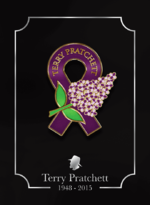Lilac: Difference between revisions
Old Dickens (talk | contribs) (new) |
No edit summary |
||
| Line 1: | Line 1: | ||
[[File:Lilac Badge.png|right|thumb|150px|Lilac Badge produced for [[Book:Terry Pratchett's Memorial Folio|Terry Pratchett's Memorial]]]] | |||
Sprigs of '''lilac''' were used as impromptu insignia by the forces of the brief but [[Glorious Revolution]] in Ankh-Morpork; survivors wear lilacs in remembrance on May 25. This [[Book:Night Watch|mention]] has led, since Terry Pratchett's ''embuggerance'' to the flower's adoption as the symbol of support for Alzheimer's research fundraising. | Sprigs of '''lilac''' were used as impromptu insignia by the forces of the brief but [[Glorious Revolution]] in Ankh-Morpork; survivors wear lilacs in remembrance on May 25. This [[Book:Night Watch|mention]] has led, since Terry Pratchett's [[TV and Film:Terry Pratchett Living With Alzheimer's|''embuggerance'']] to the flower's adoption as the symbol of support for Alzheimer's research fundraising. | ||
==On Roundworld== | ==On Roundworld== | ||
| Line 9: | Line 9: | ||
The wood is tough and flexible and has been used for inlays in cabinetry, carving and even for bows (archery). | The wood is tough and flexible and has been used for inlays in cabinetry, carving and even for bows (archery). | ||
[[Category:Things]] | [[Category:Things|Lilac]] | ||
[[Category:Discworld Flora & Fauna | [[Category:Discworld Flora & Fauna|Lilac]] | ||
Latest revision as of 17:55, 20 November 2017

Sprigs of lilac were used as impromptu insignia by the forces of the brief but Glorious Revolution in Ankh-Morpork; survivors wear lilacs in remembrance on May 25. This mention has led, since Terry Pratchett's embuggerance to the flower's adoption as the symbol of support for Alzheimer's research fundraising.
On Roundworld
Syringa vulgaris is a large deciduous flowering shrub, popular for its fragrant and attractive blossoms. Originating in the Balkans, it has been introduced across much of the north temperate zone as an ornamental garden plant and tends to follow human habitation (somewhat like rats). Flowers range in color from deep purple through pink to white. The flower (or color) has symbolised early love and mourning in the "flower language" of eighteenth and nineteenth-century Europe.
Wikipedia suggests that "it is not regarded as an aggressive species". This may be disputed by many who have examples advancing through their gardens.
The wood is tough and flexible and has been used for inlays in cabinetry, carving and even for bows (archery).